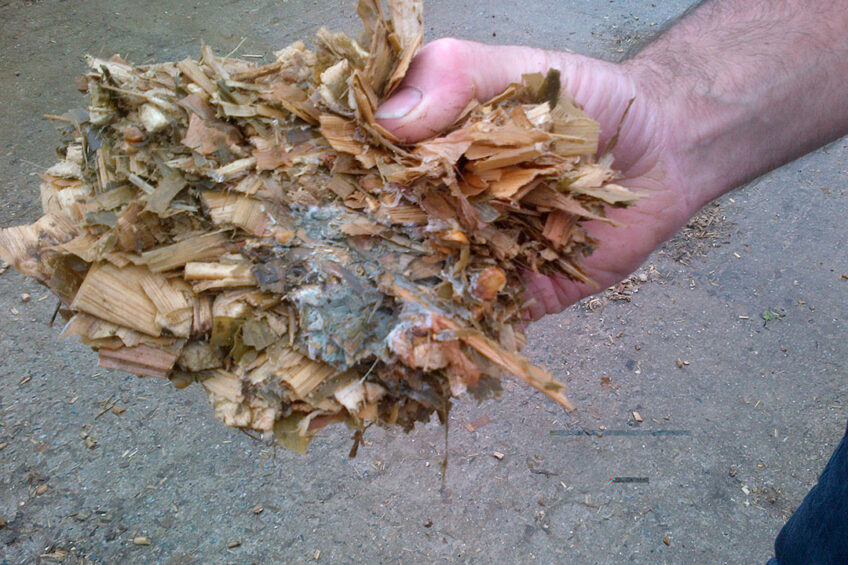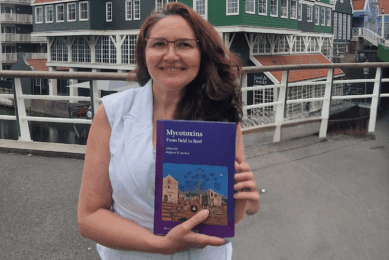Less mycotoxins with good silaging

Prior to harvest, it is very difficult to control Fusarium and toxin production. For that reason, Fusarium toxins constitute a major threat for dairy health and performances. In addition to good silage practices, one strategy to efficiently protect dairy herds is the use of a wide-spectrum toxin binder.
In dairy cows’ diet, forages are the most important components representing more than 60% of the total daily feed intake. In order to increase nutritive values and digestibility of forages, corn silage is now widely used worldwide for its high and uniform nutritional quality (1,5 MCal/kg DM in average), ease of cultivation and high yields (up to 3 times more dry matter per hectare than grass). But many research studies observed that corn silage is the main contributor of mycotoxins ingested by cows.
A survey run in 24 Dutch farms revealed that mycotoxins ingestion from ensiled forage was three times greater than for other feed ingredients (Driehuis et al., 2008). A review of literature concludes that the total amount of mycotoxins from corn silage is often higher than the maximum concentrations allowed or recommended by authorities (Ogunade et al., 2018).
Several factors contribute to the high contaminations found in corn silage:
- higher development of moulds in stem and leaves comparing to cob,
- conditions of harvest,
- storage conditions. etc.
Corn silage is often contaminated by a mixture of pre-harvest and post-harvest mycotoxins depending on temperature, water activity (aw), oxygen availability and pH conditions (Coulombe, 1993).

Pre-harvest conditions
Weather conditions play a major role in mycotoxins production in the field. Many studies reveal that deoxynivalenol (DON) is the most frequent mycotoxin in corn silage (Cogan et al., 2016) and can be used as a marker of Fusarium mycotoxin occurrence (Sobrovà et al., 2010, Slikovà et al., 2013). ZEA (zearalenone ) co-occurs with DON as they are both produced by Fusarium graminearum but surveys show that ZEA is often detected in lower level than DON. Other Fusarium mycotoxins (enniatins, beauvericins, fusaric acids and moniliformin) are commonly detected but with lower occurrence and level of contaminations (Ogunade et al., 2018). During very hot periods (>32°C), high humidity or drought stress, Aspergillus flavus can develop in field even if Aspergillus are more known as post-harvest moulds. Some cultivation methods have been identified for their impact on Fusarium development like selection of resistant varieties, management of crop residues, rotation, use of irrigation system to prevent drought, proper fertilisation and spread of pesticides (with public health concern) or bio-agents (Edwards 2004; Whitlow and Haglet, 2005). Insect damages can significantly increase the contamination in Fusarium toxins and aflatoxins as it predisposes corn to fungal diseases (Munkvold, 2014).
Harvest conditions
No specific mould or mycotoxin develop specifically at harvest, but harvest conditions must be well adjusted to minimise aggravating conditions. Several studies suggest that harvesting corn at an ideal dry matter, ranging from 30 to 35%, contributes to reduce mycotoxins concentration, probably due to less time in the field compared with high-maturity plants and also because dry silage is more difficult to compact so more predisposed to the presence of oxygen and heating leading to mould growth (Boudra and Morgavi, 2008). It’s also highly recommended to quickly seal silage to optimise anaerobic conditions. The cutting height must also be well adjusted to minimise soil contamination that is rich in Fusarium inoculum (Jouany, 2007).
Post-harvest conditions
Post-harvest moulds generally grow under lower water activity levels comparing to pre-harvest moulds. During storage, many spontaneous moulds can develop but not necessarily produce mycotoxins, meaning that the presence of moulds is not a reliable indicator of mycotoxin contamination (Zain, 2011). Aspergillus and Penicillium are the 2 main strains of post-harvest moulds that develop in the presence of oxygen. Aspergillus is more frequent in tropical and sub-tropical regions (Cheli et al., 2013) as it prefers higher temperatures and mostly produce aflatoxins. Aflatoxin occurrence is generally lower than other mycotoxins in well-preserved silages, whereas high concentration of aflatoxin can occur when silages are stored in poorly conditions. Aflatoxins are often quantified in feed materials as they are particularly of concern regarding human health. In fact, aflatoxins are the only mycotoxins that can be significantly transferred into the milk in addition of being highly carcinogenic. Penicillium moulds can grow under lower temperature, oxygen and pH conditions comparing to Aspergillus. In 2008, Gonzales-Pereyra et al., demonstrated that poor compaction, poor sealing, and low feed-out rate promote aerobic conditions and favour the growth of toxic moulds. It is strongly recommended to maintain a firm silo face, to feed-out at a rate of 10-16 cm/day and to seal silo with oxygen film in order to limit mycotoxin production (Jouany 2007; Borreani et al., 2018). When storage conditions are not optimum, inoculum of pre-harvest moulds like Fusarium will find favourable conditions for their proliferation, leading to an important accumulation of Fusarium toxins in the final diet (Figure 1). The use of preserving additives, such as inoculant or organic acids, will help to secure storage conditions and prevent toxins production at post-harvest but won’t have any impact on toxins produced prior to harvest (Binder et al., 2007; Kristensen et al., 2010).
Figure 1 – Fusarium mould and toxins growth during post-harvestin silages (adapted from Wambacq et al., 2016 and Boudra etal., 2009).
Consequences and protection
It is now clear that most of the mycotoxins found in corn silage are already present prior to harvest, thus Fusarium mycotoxins are the most occurring mycotoxins in dairy cows’ diet, DON and fumonisins being the major ones. Fusarium toxins exert their effects through three primary mechanisms in dairy cattle: immunodepression, reduction in feed efficacy and gut integrity, and alteration of reproductive performance (Gallo et al., 2015). These three primary mechanisms, even with low level of mycotoxins, provoke pathologies such as decreased performance, lower body condition, liquid faeces, increased somatic cells counts and mastitis, lameness, etc. Even if good silage management permits to prevent growth of moulds and toxins during post-harvest phase, it is very difficult to control Fusarium and toxin production prior to harvest. As a consequence, Fusarium toxins constitute a major threat for dairy health and performances, and the use of a wide spectrum toxin binder in addition to good silage practices, allow to efficiently protect dairy herds.
Mycotoxin Knowledge Centre: For everything you need to know about mycotoxins – from prevalence to prevention and control
The World Mycotoxin Forum goes to Asia! The world leading independent mycotoxin conference – The World Mycotoxin Forum – is spreading its wings and will organise the first Asia edition in January 2020. The event will be organised by Misset International, the publisher of the international multimedia brand All About Feed, in cooperation with Bastiaanse Communication, the creator and organiser of the regular editions of the World Mycotoxin Forum. WMFmeetsASIA will be held 13-15 January 2020 in Bangkok. Registration is now open. |
Join 13,000+ subscribers
Subscribe to our newsletter to stay updated about all the need-to-know content in the dairy sector, two times a week.











